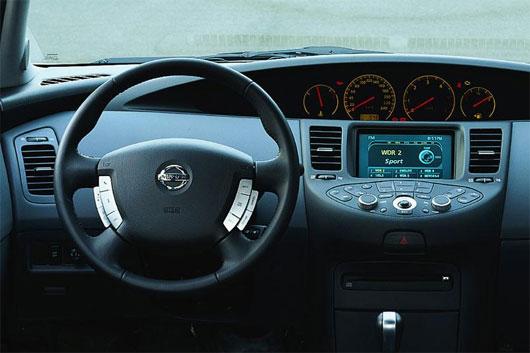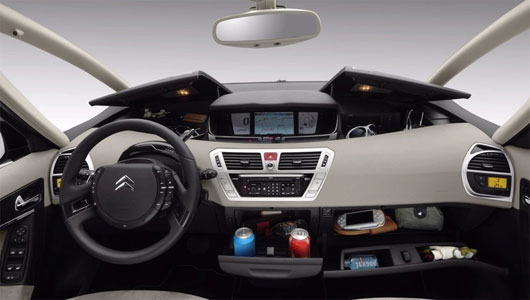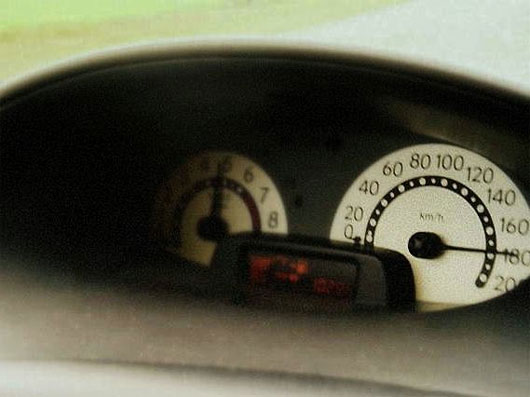Why does the middle speed dashboard disappear?
Currently most of the cars in the market have a speedometer located in the rear of the driver's steering wheel. However, if you notice, on some special cars like the Yaris or Vios, the speedometer is in the center of the dashboard. So why do car manufacturers think of this design? What benefits does it bring to users? And why with so many good points but the middle meter table gradually disappeared in the market?
In fact, the information about how to design a mid-speed clock is born or the first car to adopt this design has not been clearly recognized. But back in the early years of the 21st century, we will see a lot of cars from Toyota and Nissan firms that have speedometer between the dashboard like Previa, Vios, Prius, X-Trail, Quest, Primera , .

On the Nissan Primera 2002
In 2004, Toyota had an official announcement sent to the press as well as its car dealerships that it would expand the design of the speedometer that they called "Universal Design" on the next models. in the US market. In it, they list many benefits of this design compared to the speedometer behind the traditional steering wheel. Of course to come to this conclusion Toyota has undergone many censorship experiments, with safety criteria placed on top.
According to Toyota, the design of a mid-speed dashboard will be easier to observe and not be blocked from view when we drive the cross-over the traditional model. Besides, our eyes can always cover the road even though we are watching the parameters on the dashboard. It can be imagined like this, because our eyes are side by side horizontally, so our vision is always extended to two sides rather than from the top down. That's why the TV we watch or the glasses we wear all have a length ratio greater than the height.

On the Citroen C4 Grand Picasso 2007
Back to the problem, due to our view of expanding horizontally, when observing the parameters on the speedometer table placed behind the steering wheel in the tradition, our eyes will move a segment downwards and the vision is complete. all isolated from the road. Meanwhile, with the high-level clock set in the middle of the dashboard, our eyes will have less movement and can always be observed on the front road . So the new design theory will help us drive safer.
Another reason is that the distance between the speedometer table located between the dashboard and the driver's eye is farther than the traditional model. So it is also friendly with older customers, who often have farsightedness and have difficulty seeing objects at close range. Toyota also announced that nearly 20% of the population in Japan is 65 or older, so nearly half of its cars in the Japanese domestic market have adopted new designs.
Moreover, component manufacturers for major automakers also benefit because the mid-speed dashboard will help them less adjust their designs between the reverse and forward steering markets. Therefore, production costs are also reduced accordingly.

There is a reason anyone could guess.Passengers can monitor the driver's speed to take prompt measures.Especially when taking a taxi or sharing a car with available "speed" hands.
With such practical benefits, shortly afterwards the mid-speed dashboard was gradually noticed by many other automakers such as Citroen, Saturn, Scion and even Mini. Unfortunately, the new design encounters a lot of non-positive comments from customers and mostly around the issues: it's hard to use due to time-consuming changes in habits, the clock table is in the middle. - makes the steering wheel part empty and not as beautiful as the traditional one.
If you join the forums about cars in Vietnam, we even come across many opinions of concern that using a mid-speed speedometer may cause the user to squint or flick the neck. But really, the world has not recorded any cases of trauma or disability due to the long-term use of this new design.

Nissan Quest 2004 with a speedometer between the dashboard makes the dashboard look like the dashboard of a flying saucer that has been seen in some science fiction movies.Strange and beautiful!
And then in 2008, Nissan was the first company to begin eliminating the mid-speed clock design out of its new models. That also brings other firms back to the traditional design, including Toyota. The typical example is the model Yaris (also known as Vios, Vitz, Echo), which spent the first two generations with a speedometer in the middle of which has returned to the position behind the steering wheel on the 3rd generation.

2nd generation Yaris (2007-2012)

The 3rd generation Yaris (2013-present) with the speedometer back to the position behind the wheel
The reason why the speedometer between the clock gradually disappears can explain easily according to economics. This is a typical case where product functionality or benefits cannot win over user habits. Everything was so clear, though the design of the watch table in the middle made us not have to take our eyes off the road. But the time we see the parameters on this watch is usually only 1-2 seconds, which is very little compared to the driving time. Therefore the difference is negligible, especially when compared to more than 95% of drivers are familiar with the traditional watch table style. Moreover, today the trend of the entertainment information system on cars is growing, forcing the speedometer to return to the right position behind the steering wheel to give space to the display in the center. -Lot.
- Winter will disappear in the North after a few years
- Ice in the Arctic is likely to disappear by 2030
- The truth of mythical myths about the Middle Ages
- US will speed test the speed of 1,100km / h
- Korea develops 'fast as lightning speed train'
- Is there a black hole that will swallow Earth?
- The last chance to visit these 12 islands before it completely disappears
- Middle-aged exercise is good for the heart
- 2100: many earth climates will disappear
- The evolution of humanity will make wisdom teeth disappear
- The 12,000-year-old ice shelf is about to disappear
- 7 mistakes when using the high speed can cause the electric drive to explode, causing harm to the whole family
 'Fine laughs' - Scary and painful torture in ancient times
'Fine laughs' - Scary and painful torture in ancient times The sequence of numbers 142857 of the Egyptian pyramids is known as the strangest number in the world - Why?
The sequence of numbers 142857 of the Egyptian pyramids is known as the strangest number in the world - Why? History of the iron
History of the iron What is alum?
What is alum?